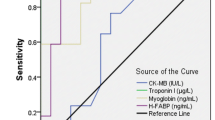Abstract
Laboratory infarction diagnostics are based on the detection of elevated serum activities of creatine kinase (CK) Creatine kinase Isoenzyme MB (CKMB) and Transaminases. Determination of these cardiac marker enzymes permits the diagnosis of transmural myocardial infarction. However in such patients the diagnosis of acute myocardial infarction can be confirmed by the clinical symptoms and changes in the ECG, in addition to the enzyme assays. The 50 AMI patients selected in the present study were those admitted to the ICCU of Shri Krishna Hospital, Karamsad. The blood samples were taken at Zero hours (i.e. at the time of admission of the patient). Within 6 hrs of the starting of chest pain, 1.5 million units of streptokinase were mixed with 100 to 150ml of normal saline and administered by infusion over a period of one hour. The blood samples were further collected at intervals of 6 hrs, 14hrs, 32hrs, 48hrs, 5th day and 7th day. The blood samples were analyzed for CK, CKMB, SGOT, α HBDH and Cardiac specific Troponin T. By 6hrs the CK and CKMB values had started rising, the rise continuing at 14hrs with peak values at 32hrs. The CK showed a slight decrease by 48 hrs. The cardiac Troponin T showed wide time window from 4 hrs to 7th day for detecting myocardial damage. The maximum cardiac Troponin T values were during the first 24hrs. Cardiac Troponin T in serum appears to be a more sensitive and early indicator of myocardial cell injury in comparison to CKMB.
Similar content being viewed by others
References
Neumeir D. Activity kinetics and diagnostic significance in myocardial Infarction. Clinical chemica acta 1996; 73: 445–51.
Hafkensheid JCM. J Clin chem clinical biochem 1979; 17: 219.
Remppis A, Scheffaid T, Karrer O, Zehelein J, Hamm C Ketus, K. A. Assessment of reperfusion of the infarct zone after acute myocardial infarction by serial cardiac Troponin T measurement in serum, Br Heart J 1994; 71: 3: 242–6.
Lee T H, Rouan G W, Weiberg M. C. Sensitivity of routine clinical criteria for diagnosing myocardial infarction within 24 hrs of hospitalization. Ann Intern Med 1987; 106: 181–6.
Mc Queen MJ, Holder D E L, Moragi NRH. Assessment of accuracy of serial electrocardiograms in the diagnosis of myocardial infarction. Amm heat J 1983; 105: 258–6.
Rosano T G, Claysan K J, Strandjord P E Clinical Chem 1976; 22: 1078.
Krucaff N W, Green C E, Satler L F. Noninvasive detection of coronary Artery potency using continuous ST segment monitoring. Am J Cardiol 1986; 57: 916–2.
Roberts R, Ishikawa Y. Enzymatic estimation of infarct size during reperfusion. Circulation 1983; 68: Suppl-1: 83–9.
Galen R S. The enzyme diagnosis of myocardial infarction. Hum Pathol 1975; 56: 141–55.
Lott J A. Serum enzyme determination in the diagnosis of acute myocardial infarction. Hum Pathol 1984; 15: 706–16.
Gama R, Swain D G. The effective use of cardiac enzyme and electrocardiogram in the diagnosis of acute myocardial infarction. Post grad Med J 1990; 775: 375–7.
Yondeda K, Katayarna Y, Takagi Y, Goni K. Early diagnosis and detection of successful reperfusion by mitochondrial AST/soluable AST ratio after myocardial infarction. Rinsho-Byoti 1995; Jan 43-1: 74–80.
Adams J E, Abendochain D R, Jaffe A. S. Biochemical markers of myocardial injury is MB creatinine kinase the choice for the 1996's? Circulation 1993; 88: 750–53.
Coliension PO, Chandar MA. Measurement of serum TnT, CKMB and total CK following ardurous physical training. Ann. Clin. Biochem. 1995; Sept. 2–32: 450–3
Ravkide J, Horder M, Gerhardt W, Liungdohi L et al. Diagnostic performance and prognostic value of serum Troponin T in suspected acute myocardial infarction. Scand J. Clin lab. Invest. 1993; 53: 677–85.
Lindohi Bertil, Pervenge MB, Lass Wallentin. MD, Ph.D. For the FRISC study group relation between Troponin T and the rise of subsequent cardiac events in unstable coronary artery disease. Circulation: 1996; 93: 1651–7.
Shah Hitesh, Haridas N. Evaluation of clinical Utility of Serum Enzymes and Troponin-T in the Early Stages of Acute Myocardial Infarction. Indian Journal of Clinical Biochemistry. 2003; 18(2): 93–101.
Reddy G, Chinnapu, Kusumanjali G, Sharada AHR, Rao Pragna. Cardiac Troponin-T and CKMB (Mass) levels in cardiac and non cardiac disease: Indian Journal of Clinical Biochemistry. 2004; 19(2): 91–4.
Author information
Authors and Affiliations
Corresponding author
Rights and permissions
About this article
Cite this article
Shah, H., Haridas, N. A serial follow up study of cardiac marker enzymes during the week after acute myocardial infarction. Indian J Clin Biochem 22, 33–36 (2007). https://doi.org/10.1007/BF02912878
Issue Date:
DOI: https://doi.org/10.1007/BF02912878




